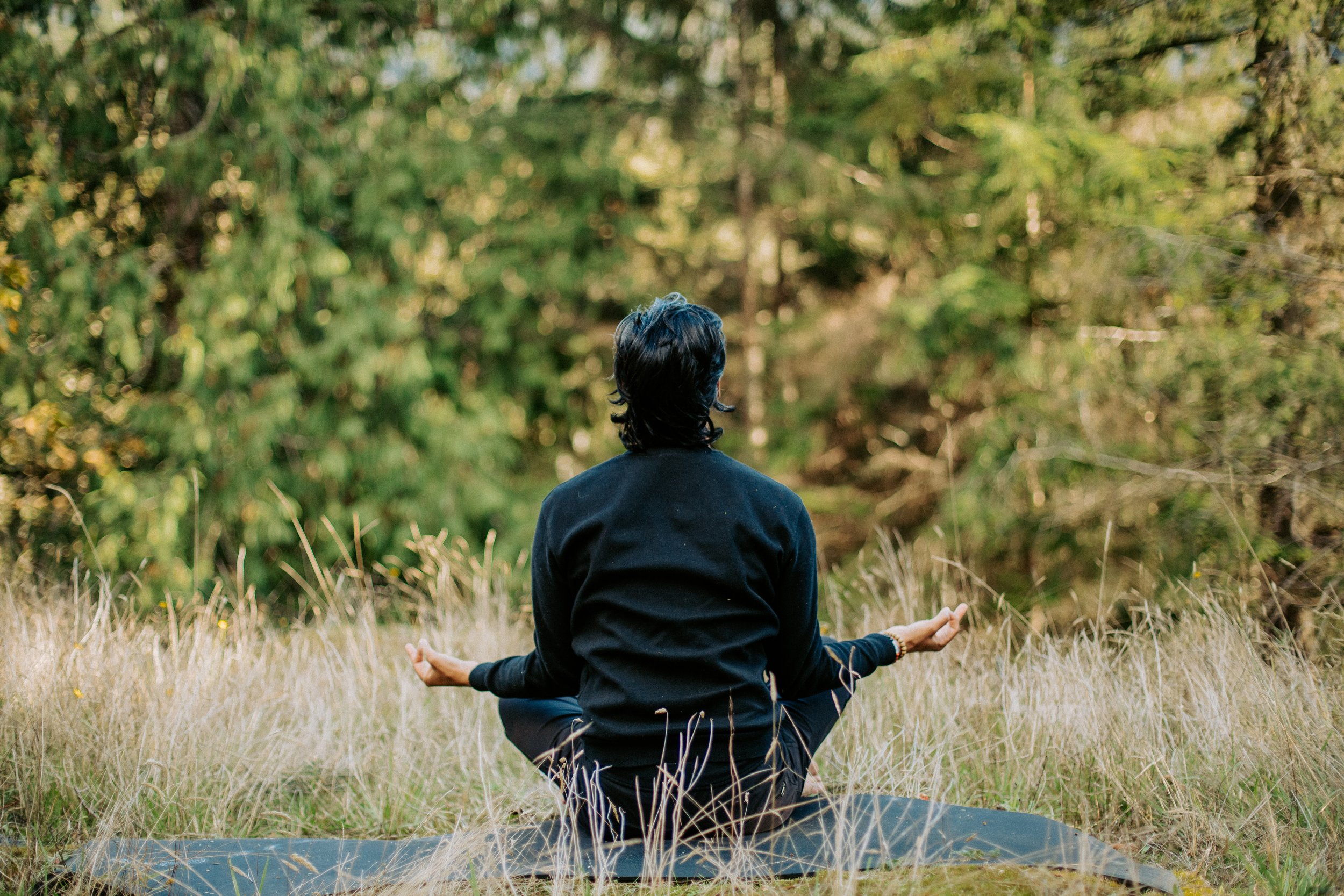At its core, Isvara Pranidhana calls upon us to release our grip on the illusion of control. The practice urges us to let go of the ceaseless pursuit of ego-driven ambitions and the false belief in our hyper-individuality-based abilities. Here at Nectar Yoga Retreat, sitting with humility as a teacher is a lifelong journey.
An Overview Of The Raja Yoga System
In Sanskrit, Raja translates to ‘king" or ‘royal," referring to the status of Raja yoga as the "royal path"’ or the predominant form of yoga. At Nectar Yoga we follow these teachings both on and off the yoga mat, curating our practices as well as the way we conduct ourselves, to demonstrate how Raja yoga can be integrated into modern daily life and the benefits it brings.
Traditionally, Raja yoga refers to the objective of yoga as well as the method of attaining it. Through this, it is also considered to be the state of peace and contentment that comes from a sustained yoga + meditation practice. It also encompasses teachings from all the different paths, and it is from Raja yoga that Hatha yoga and modern Asana practice has developed.
Considering that Raja yoga involves all three dimensions of human existence (physical, mental + spiritual), it empowers practitioners to find harmony on each of these levels.
Although Raja yoga generally emphasizes meditation to being the path to self-realization, the term has come to refer to a much more vast range of practices.
In the 19th century Raja Yoga text, Swami Vivekananda equated Raja yoga with the Yoga Sutras of Patanjali; since then Raja yoga has been used or referred interchangeably with Ashtanga yoga, or the ‘eightfold path’ to spiritual liberation.
According to Raja yoga, the largest obstacle to self-realization is a busy mind, in which uncontrolled thinking, ego, desire, attachment + separate sense of self all contribute towards suffering.
Working through each limb in Patanjali’s eight limbs of yoga brings the practitioner close to an enlightened state of consciousness known as Samadhi, in which it is possible to experience the truest version of yourself.
The eightfold path, also referred to as the eight limbs of Raja yoga are:
Yamas - Five social observances.
Niyamas - Five moral observances.
Asana - Yoga postures/poses.
Pranayama - Breath exercises to control + manage Prana (vital life force energy).
Pratyahara - Withdrawal of the senses.
Dharana - Concentration.
Dhyana - Meditation.
Samadhi - Enlightenment/bliss.
Yamas
The self-awareness gained by practicing the five Yamas can aide in transforming negative energy to a cultivation of peace. This is an overall practice of being more kind, accepting, and forgiving with both yourself and others.
The 5 Yamas are:
Ahimsa (non-violence)
The Sanskrit word “Himsa” translates to “harming, injuring, killing, or doing violence.” Ahimsa, the first of the Yamas is the practice of non-harming or non-violence both to yourself and others. This is the way of maintaining balance + harmony in your relationships in the world and with your truest self. As our journey unfolds, it leads to awareness of the tranquil yet enduring core that is our true nature; the desire to prevent harm is a natural expression of that awareness.
We begin to realize that the inner self in others is identical to our own inner self, and we wish no harm to come to any being. This includes the way we talk to and about ourselves, and others, the way we spend our time and energy, and with whom; and how we conduct ourselves out in the world, both when being “watched” and when alone.Satya (truthfulness)
Simply beyond the practice of “not lying,” practicing Satya is living in a way that aligns with your highest truth. It revolves around about being honest with yourself, with others, and abstaining from judgment — ensuring that you are consistent in speaking + acting with mindfulness and intention, rather than saying whatever is on your mind.Asteya (non-stealing)
This goes beyond the obvious of non-stealing, more than just not taking physical object that don’t belong to you. We can factor in hoarding items we don’t need, that instead can be shared with our community. As well as being aware of if we are utilizing more resources than necessary, such as letting the water run while you brush your teeth, leaving the lights on when you leave the house, etc.
But we can go deeper still – considering the act of stealing time. Time is something that, although set in a standard, reflects differently for every person. Managing our own time with grace, and showing up on time for someone else or a commitment is part of practicing Asteya.Brahmacharya (chastity)
The most talked about interpretation of Brahmacharya is celibacy. However there is a broader interpretation of this Yama; the prevention of the dissipation of one’s energy through the misuse of the senses. When you practice Brahmacharya, you are not letting the senses rule your behavior; rather practicing a personal energy-conservation program.
Anything that causes turbulence in the mind and stirs the emotions might be seen as a violation of brahmacharya: overstimulating foods, loud music, violent movies, and yes, inappropriate sexual behavior. Brahmacharya asks you to consider how you spend your energy.Aparigraha (non-possessiveness)
”Graha” translated from Sanskrit means “to grasp or to seize” and “Pari” to “things”; thus this Yama guides us in cultivating a balanced relationship with all things that we each call ‘mine.’
When we become possessive of anything, we are in turn possessed - however when we appreciate our possessions without becoming emotionally dependent on them, then they neither hold power over us nor lead to false expectations.
Niyamas
When put into practice the five Niyamas can be constructive tools for cultivating happiness and self-confidence; and when walking your path mindfully, the opportunities to practice them will present themselves every day.
Saucha (purity)
Saucha is not only the foundation for physical health, it is also the doorway to deeper and more tranquil states of meditation. Saucha encourages the practice of making mindful + wise choices surrounding your intake of food, emotions, thoughts and energy.
Keeping your thoughts uncluttered allows you be free of afflictive emotions; keeping your body + environment in order, also lends to creating a sense of calm. A mind trained by meditation has more complexity and orderliness. Physical orderliness can also positively affect the mind.Santosha (contentment)
This Niyama asks you to be aware that whatever you have in the present moment is enough. Once you can consistently do this, happiness will find an enduring place in your life. Santosha is a practice that cannot be found, rather it will find you once you have created the space for it.
On the yoga mat this can look like acknowledging your tendency to strive to do a ‘perfect pose’ yet meeting yourself where you are, using props or making modifications without feelings of shame or disappointment, rather gratitude for all your body does for you.Tapas (self-discipline)
The word Tapas is derived from the root Sanskrit verb ‘tap’ which means ‘to burn’, and evokes a sense of ‘fiery discipline’ or ‘passion’. In this sense,
when we perform our actions with full determination and effort, they are performed with Tapas.
Tapas can mean cultivating a sense of courage, self-discipline + passion in order to burn away ‘impurities’ physically, mentally and emotionally, thus paving the way to our true greatness.Svadhyaya (self-study)
The Sanskrit translation of “Sva” means ‘self,’ or ‘ own’ with “Adhyaya” translating to ‘lesson,’ or ‘reading,’ and while it can imply the practice of studying scriptures, it is also a practice of studying the Self.
When we listen to our ego, we often do or think things that do not align with our true beliefs or intuition and find ourselves reveling in fears and doubts; essentially the causing our own ‘Chitta Vrittis, (‘fluctuations of the mind). Bringing our awareness to ourselves and the way we go about our daily life allows us to become more aware of the things we do that harm us, and also that which serve us and bring us closer to that process of yoking with the our truest self.Ishvara Pranidhana (devotion or surrender)
Isvara Pranidhana is made up of two words; Isvara, which translates from Sanskrit roughly to ‘Supreme Being’, ‘Brahman’, ‘Ultimate Reality’ or ‘True Self,’ and Pranidhana, which means ‘fixing’. In most translations of this Niyama, we’re advised to ‘surrender’ to this Supreme Being or higher self, which in essence means cultivating a potent + trusting relationship with the universe, thus making each action an offering to something bigger than us. This Niyama encourages us to observe our thoughts and desires that distract us during moments of concentration, and from there redirect attention in the center of your being. At such times you may be able to transcend the limitations of your attachments and sense the presence of inner stillness.
Asana
This limb is has become equated to ‘the yoga practice’ in the modern western world, yet it is only one of many other limbs that make up the true yoga practice. postures practiced in yoga, comprise the third of the 8 limbs of yoga. In the yogic view, the body is a temple of spirit, the care of which is an important stage of our spiritual growth. Through the practice of physical postures we develop the habit of discipline + the ability to concentrate, both of which are necessary for cultivating healthy routines in life.
Pranayama
The Sanskrit word Prana translates to ‘energy’ or ‘life source’. It is often depicted as a description to the very essence that of each one of us and the energy in the universe around us. Prana is also synonymous with ‘the breath,’ and by noticing + controlling the way we breathe, we can affect the mind in a powerful way.
Generally our life force flows unconsciously out through our nervous system + senses so that we are cognitive of the world around us. Through various practices of Pranayama that same life force is directed inward toward the higher centres of spiritual awareness throughout the spine + brain, so that we may perceive the brightest path within us.
By practicing Pranayama we free the ourselves from the distractions of life by a direct means — controlling the flow of bodily energy that would otherwise keep our consciousness outward. We allow our restless thoughts to find a path of peace and become open to knowing our truest self.
Pratyahara
Pratya translates in English to ‘withdraw’, ‘draw in or back’; and the Sanskrit word “Ahara” refers to what we ‘take in,’ - such as sights, sounds + smells our senses constantly take in. The practice of drawing inward may include bringing our awareness to our breath, our actions, our emotion, and our responses through day to day life.
Withdrawal as a term, may initially bring to mind the idea that we are practicing a form of turning our senses ‘off’ through concentration + intention, which is why this aspect of practice is often misunderstood.
Rather than dampening our senses through awareness of our state of being, the practice of Pratyahara changes our state of mind so that we become so in tune with what it is we are focusing on, that the world around us no longer distracts us and we are able to meditate or bring intentional awareness within, without becoming easily distracted.
Dharana
Dharana means ‘a focused concentration’. With Dha translating to ‘holding or maintaining’, and Ana meaning ‘other’ or ‘something else’.
Linked particularly close to the previous limb, Pratyahara with the understanding that in order to focus on something, the senses must withdraw so that all attention is put on that point of concentration, and in order to draw our senses in, we must focus and concentrate intently. The exercise of Tratak (candle gazing in an otherwise dark room), visualisation, and focusing on the breath are all practices of Dharana.
Dhyana
Dhyana is the Sanskrit word that translates to “meditation.” It is derived from the root words, Dhi, meaning “receptacle” or “the mind”; and Yana, meaning “moving” or “going.”
The seventh limb builds upon the practices of Asana, Pranayama, Pratyahara + Dharana. When practiced together with Dharana and the eighth limb of Samadhi, the yogi does not see it as a meditation practice; as they are so fully immersed that they can no longer separate the self from the practice.
Samadhi
Many of us know the eighth limb Samadhi as reaching ‘bliss’ or ‘enlightenment’, and in a sense it’s an accurate relation when practices of having reorganised our relationships with both the outside world and our own inner world, are being exercised.
Breaking the term into its’ individual Sanskrit words, we see that this final limb is made up of two words; Sama translates to ‘same’ or ‘equal’, and Dhi means ‘to see’. There is a reason it’s referred to as a ‘realization’ or ‘coming to,’ as Samadhi is not about leaving the world around you, it’s about truly noticing the very life that lies in front of you.
One of the most important things to remember is that Samadhi is not a permanent state once achieved… rather a consistent sum of practices working towards it. Mindfully shedding our attachments, aversion, influences from ego, desires + habits, particularly in the modern western world is a life-long practice
Once the mind is pure and we truly do experience a state of Samadhi we can keep hold of, we attain Moksha, (also known as Mukti,) meaning a permanent state of being liberated + free.
These eight limbs offer a systematic approach to calming the mind + seeking the path of freedom. Raja yoga is ultimately a means of transcending identification with the body-mind-intellect complex in order to truly recognize and know the nature of your truest self.
Gratitude to our community near and far, both for taking the time to explore our blog and for walking the path to your best self - we hope this resonated and aids you in finding balance within.
Thanks and credit goes to the many talented writers + resources provided by Yoga International, Yoga Journal + Eckhart Yoga
All Photos - Nectar Yoga Copyright

























